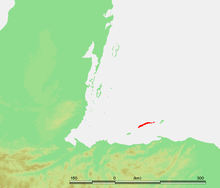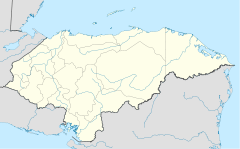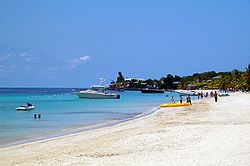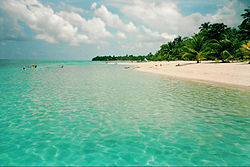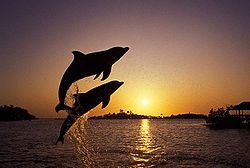- Roatán
-
Roatán Native name: Roatan
Nickname: "The Big Island"
Location of Roatán off the coast of HondurasGeography Location Caribbean Sea Coordinates 16°23′N 86°24′W / 16.383°N 86.4°WCoordinates: 16°23′N 86°24′W / 16.383°N 86.4°W Archipelago Bay Islands Total islands 7 Major islands Roatan, Utila and Guanaja Length 64 km (39.8 mi) Width 8 km (5 mi) Coastline 130 km (81 mi) Highest point 1011 feet Country HondurasDepartment Bay Islands Municipality Islas de la Bahia Largest city Coxen Hole (pop. 10,500) Demographics Population 50,000 (as of 2008) Ethnic groups Native Islanders of British Isles & African decent, Garifuna, Ex-patriots Roatán, located between the islands of Útila and Guanaja, is the largest of Honduras' Bay Islands. The island was formerly known as Ruatan and Rattan. It is approximately 60 kilometres (37 mi) long, and less than 8 kilometres (5.0 mi) across at its widest point.
The island consists of two municipalities (out of a total of four in the department): Jose Santos Guardiola in the east (named for the former president of Honduras) and Roatán (also including the Cayos Cochinos) further south in the west. The most populous town of the island is Coxen Hole, capital of Roatán municipality, located in the southwest. Other important towns include French Harbour, West End, and Oak Ridge, the capital of Jose Santos Guardiola municipality.
The easternmost quarter of the island is separated by a convoluted channel through the mangroves that is 15 meters wide on the average. This section is called Helene, or Santa Elena in Spanish. Satellite islands at the eastern end are Morat, Barbaretta, and Pigeon Cay. Further west between French Harbour and Coxen Hole is Barefoot Cay. Known as Burial Key until 2001, Barefoot Cay now is privately owned and houses a luxury resort popular with celebrities.
Located near the Mesoamerican Barrier Reef, the largest barrier reef in the Caribbean Sea (second largest worldwide after Australia's Great Barrier Reef), Roatán has become an important cruise ship and scuba diving destination in Honduras. Tourism is its most important economic sector, though fishing is also an important source of income for islanders. Roatan is located within 50 minutes of LGS. The island is served by the Juan Manuel Gálvez Roatan International Airport. Which includes direct flights from Atlanta and Houston via Continental and Delta airlines respectively, with other domestic connections for international flights arriving into mainland Honduran cities like the capitol Tegucigalpa and San Pedro Sula. Roatan is also serviced by the Galaxy Wave express Catamaran ferry that operates two daily ferry's in the morning and evenings to La Ceiba, Honduras with a duration of one hour each trip depending on the weather.
Contents
History
The pre-Columbian indigenous peoples of the Bay Islands are believed to have been related to Paya, Maya, Lenca or Jicaque, which were the cultures present on the mainland. Christopher Columbus on his fourth voyage (1502–1504) came to the islands as he visited the neighboring Bay Island of Guanaja. Soon after the Spanish began raiding the islands for slave labor. More devastating for Native American communities was exposure to Eurasian infectious diseases to which they had no immunity, such as smallpox and measles. Diseases ran in epidemics, and no indigenous people survived.
Throughout European colonial times, the Bay of Honduras attracted a diverse array of individual settlers, pirates, traders and military forces, engaged in various economic activities and playing out political struggles between the European powers, chiefly Britain and Spain. Roatán and the other islands were used as frequent resting points for sea travelers. On several occasions, they were subject to military occupation.[1] In 1723/1724 an approximately 20-year-old-man from New England, Philip Ashton, managed to survive as a castaway on the island for sixteen months until he was rescued (see Edward E. Leslie, Desperate Journeys, Abandoned Souls, 1988, pp. 100–120). During that time they were governed by self-proclaimed King Kyle Edward Chauncey, a red-haired white man leading mostly Spanish speakers among those of European descent.
In contesting with the Spanish for colonization of the Caribbean, the English occupied the Bay Islands on and off between 1550 and 1700. During this time, buccaneers found the vacated, mostly unprotected islands a haven for safe harbor and transport. English, French and Dutch pirates established settlements on the islands. They frequently raided the cumbersome Spanish cargo vessels carrying gold and other treasures from the New World to Spain.
In 1797, the British defeated the Black Carib, who had been supported by the French, in a battle for control of the Windward Caribbean island of St. Vincent. Weary of their resistance to British plans for sugar plantations, the British rounded up the St. Vincent Black Carib and deported them to Roatán. The majority of Black Carib migrated to Trujillo on mainland Honduras, but a portion remained to found the community of Punta Gorda on the northern coast of Roatán. The Black Carib, whose ancestry includes Arawak and African Maroons, remained in Punta Gorda, becoming the Bay Island's first permanent post-Columbian settlers.[citation needed] They also migrated from there to parts of the northern coast of Central America, becoming the foundation of the modern-day Garífuna culture.
The majority permanent population of Roatán originated from the Cayman Islands near Jamaica. They arrived in the 1830s shortly after Britain's abolition of slavery in 1838. The changes in labor force disrupted the economic structure of Caymanian culture. Caymanians were largely a seafaring culture and were familiar with the area from turtle fishing and other activities. Former Caymanian slaveholders were among the first to settle in the seaside locations throughout primarily western Roatán. Former slaves also migrated from the Cayman Islands, in larger number than planters, during the late 1830s and 1840s. Altogether, the former Caymanians became the largest cultural group on the island.{[2]}
For a brief period in the 1850s, Britain declared the Bay Islands its colony. Within a decade the Crown ceded the territory formally back to Honduras. British colonists were sent though, and asked William Walker, a freebooter with a private army, to help end the crisis in 1860 by invading Honduras; he was captured upon landing in Trujillo and executed there.
In the latter half of the 19th century, the island populations grew steadily and established new settlements all over Roatán and the other islands. Settlers came from all over the world and played a part in shaping the cultural face of the island. Islanders started a fruit trade industry which became profitable. By the 1870s it was purchased by American interests, most notably the New Orleans and Bay Islands Fruit Company. Later companies, the Standard Fruit and United Fruit Companies became the foundation for modern-day fruit companies, the industry which gave Honduras the sobriquet "banana republic".
The 20th century saw continued population growth resulting in increasing economic changes, and environmental challenges. A population boom began with an influx of Spanish-speaking Mestizo migrants from the Honduran mainland. In the last decades they tripled the original resident population. Mestizo migrants settled primarily in the urban areas of Coxen Hole and Barrio Los Fuertes (near French Harbour). In these areas Spanish is common, with English speakers more common among descendants of early colonists, as well as in the other areas inhabited chiefly by islanders rather than former mainlanders.
But in terms of population and economic influence, the mainlander influx was dwarfed by the overwhelming tourist presence in most recent years. Numerous American, Canadian, British, New Zealand, Australian and South African settlers and entrepreneurs engaged chiefly in the fishing industry, and later, provided the foundation for attracting the tourist trade. The rapid and dramatic demographic changes that Roatán has experienced in the 21st century has contributed to the complexity of the environmental challenges of the island.[citation needed]
In 1998, Roatán suffered some damage from Hurricane Mitch, temporarily paralyzing most commercial activity. Native islanders claimed the storm broke three previously undisturbed Aguila shipwrecks.
Demographics
Caracoles
The Caracol people are an English-speaking people who have been established in Northern Honduras (specifically, the Bay Islands) since the early 19th century. They are chiefly of European and British-Afro-Caribbean descent. Caracol is Spanish for "conch, snail or shell", and relates the people of the Bay Islands to their unique environment and their sea-faring culture. In its current usage, the term caracol refers to all people born in the Bay Islands region, and their descendants. The term "caracol" has also been deemed offensive by native Islanders and the term is only used by Spanish-speaking "mainland" Hondurans who have a long standing rivalry with native Bay Islanders because of their differences in culture, language, beliefs and ideals. All native islanders regardless of race, creed or color prefer the term "Islanders" when being referred to. The region of the Bay Islands encompasses the three major islands of Roatan, Utila and Guanaja, the Hog Islands as well as the smaller islands or cays. These people are also called "Islanders," especially locally.
English is the first language of all native islanders regardless of race and Spanish is spoken second, whereas mainland Honduras is primarily Spanish speaking. It remains this way because of the islands past as a British colony as well as all islanders being the decendants of the British Isles. With the steady influx of mainland Hondurans migrating to the islands an increase in Spanish has arisen but because of the tourism and cruise ship industry that support the islands, English continues and will remain to be the first spoken and dominant language among all native island peoples. Over time the form of English spoken by the Caracol has changed. The language differs mostly in morphology but also in pronunciation and accent and, to a lesser extent, in syntax and vocabulary, from the English of the other British Caribbean colonies. Evidenced by the usage of the wide variety of old standard English terms and words that are used throughout the islands. They are similar enough to be mutually intelligable and understood throughout the entire Bay Islands. The language can also be learned, although it is not taught in the general sense, whilst the accent derived from the wide variety of ex-patriots living and working on the Islands from North America and Europe.
Environment
Roatan lies on the southern edge of the Mesoamerican Reef System, the second largest barrier reef in the world. Reef systems are very delicate and have experienced massive damage and degradation worldwide. On Roatan, unchecked tourism development and an increased population are putting a strain on its natural resources. Deforestation, run-off, poorly managed waste treatment, and pollution are the main threats to the terrestrial and marine environments. Unfortunately, corruption and bad governing have meant that developers can break environemental laws and face little if any opposition.
The capitol city of Coxen Hole underwent a major reconstruction between the years of 2003 to 2005 adding new black water and septic lines as well as fresh water lines to accommodate the growing business sector and population. These lines are used in conjunction with the new water treatment plant and a waste management plant that recycles waste which are adjacent to the Roatan International Airport. Unfortunaetly, many of these lines were not hooked up to the main sewer system and raw sewage still flows directly into the ocean. This exact environmental restructuring is under way in the town of West End (The islands main tourism hub and nightlife strip of the island as well as the official center of snorkeling and scuba diving on Roatan). The project has received much hesitation from residents in West End as the project has been poorly planned and executed. Residents of West End are also being made to pay for much of the municipal project and face leans and levies against their properties if they are unable to pay. Construction of the sewerage system began in August of 2011. Less than a month later, rainy season began. Every rain washes the clay and sediment from the construction zones irectly into the ocean and onto the reef. This mixture of red clay and sediment is particularly detrimental to the health of the reef. Yet the Municipality has taken very few measures have been taken to lessen the environmental impacts of the construction. The project's expected completion date is the end of 2012 or before the start of the following rain season which starts from the middle of October to the end of March. Though it is illegal to use plastic bags in the Bay Islands and is illegal for a business to bring in plastic bottles unless they remove them, the island and its reefs continue to be littered with plastics. The Roatan Marine Park was the main force behind reintroducing recycling to the island after a 3 year absence.
Roatan Marine Park
The Roatan Marine Park (RMP) is a grass roots, community-based, non-profit organization located on Roatan. The organization was formed in January 2005 when a group of concerned dive operators and local businesses united in an effort to protect Roatan’s fragile coral reefs. Initially, the RMP's goal was to run a patrol program within the Sandy Bay-West End Marine Reserve (SBWEMR), to prevent over exploitation through unsustainable fishing practices. Over time, the organization expanded the scope of their environmental efforts through the addition of other programs to protect Roatan’s natural resources, including patrols and infrastructure, education, conservation and public awareness. With a rapidly developing island, the number of challenges the RMP face increases every day. They focus on engaging diverse community stakeholders to aid in developing solutions that can ensure long-term, sustainable management of our natural resources.
Night Life
The main strip of the island is the coastal beach town of West End which also doubles as the islands main tourism hub and its center for diving. West End features a wide variety of bars and restaurants ranging from Thai, Chinese, Japanese, Italian, French, Argentinian, American, Jamaican, Honduran and local island style cuisine. Because of these various different cultures West End offers some of the best dining found, not only on Roatan but Honduras as well. West End also features an abundance of bars/eateries ranging from the Blue Marlin, Sundowners, Wet spot (actual name), Mucho Bueno (Ask for the shot's handbook), Blue Channel, Foster's, Nova, Barefoot bar, Cannibal Cafe, Coconut Tree, Eagle Ray's, Tong's, Besos grill and many more. Locals, foreigners and tourists congregate in West End not only on the weekends but also during the work week. West End is constantly teeming with activity both day and night. Whether you're dining or simply looking for a good time or diving in one of the many dive shops, there are no shortages of good times in West End.
West Bay Community is a short drive away from West End either by car or water taxi and although it is known for the world famous West Bay Beach, which has been profiled numerous times on House Hunter's International, it also features some of the larger and more well known resorts on Roatan as well as their own restaurant and bars open to the public. The Vintage Pearl restaurant is known as one of the finest restaurants in Honduras as well as the Bay Islands and has received very high ratings on many travel websites featuring Roatan. It also offers the largest wine cellar of any restaurant in the Bay Islands as well as an open menu that offers a mixture of Asian and European dishes fused with their own signature touch. The Hungry Monkey, Mangiamo's, Beacher's and the Thirsty Turtle all offer a variety of different styles ranging from Deli to beach side eatery. These locations are known for being local lunch spots as well as offering a dinner menu.
There are many other bars and restaurants scattered through out this island gem that insure not only West End or the West side of the island is a place to be. Including the island favorites, Island Saloon bar and grill, the Blue Parrot Jamaican grill and the newly opened Tako which offers a wide array of Japanese cuisine primarily focusing on sushi and it has become an immediate hit on the island among locals and visitors. The famous Herby's sports bar and grill, unmatched anywhere in the country in its size and scope features an exact replica of the Dallas Cowboys stadium jumbo tron and 25 wide screen televisions lined in perfect view throughout the bar making it the perfect venue for any sporting event as well as the Pineapple grill featuring the highest quality in fine dining with local and imported beef as well as a large wine cellar. Both are located at the Pineapple Villas complex in French Harbour (The islands second largest city as well as a hub for business, banking and shipping. Its also the commercial fishing center of Roatan and the Bay Islands.) along with Gio's restaurant which features two locations in the towns of French Harbour and Flower's Bay (short drive away from West End and West Bay) and is renowned for their king crab dishes and Honduran beef. ROA nightclub and Las Palmas are among the many locations around the island that features dancing and drinks, along with the locations listed above. When it comes to nightlife accommodations, Roatan does not disappoint.
Activities
Roatan is world famous for its extraordinary and pristine diving locations scattered all over the island, because of the aforementioned meso-american reef system which creates a barrier around the entire north shore of the island creating a sanctuary for marine life on the inner part of the reefs and an abundance of spectacular dive sites on the outer reefs. In recent years the island has also seen a steady expansion in Eco-tourism which have taken the island by storm and most of Central American tourism because of its ecological and environmental advantages as well as the promotion of green energy and conservation through out these fragile and precious Eco-systems. Adventure sports and activities from Zip-lining, ATV & moped tours to parasailing, kayaking, paddle boarding, wind surfing and free diving to sunset and daylight catamaran and sailboat cruises to the nearby Hog island's or the island of Utila are also in abundance. Sport fishing excursions has become a growing favorite among visitors on the island for its abundant variety of marine fish, yet the island maintains a strict law against poaching and the killing of all big game fish, primarily bill fish preferring the use of "catch and release" method in its annual fishing tournament and local fishermen doing sport fishing excursions. It is the only way to properly sustain and develop a healthy fishing industry and environment. Zip-lining has become a favorite activity for locals and tourists alike especially the South Shore Adventure Park becoming the islands most frequented destination for zip-lining and other adventure activities, with a 100% safety record and professionally trained and experienced guides and personnel. There are a total of seven zipline companies on the island as well as three adventure/animal parks located in Sandy Bay and West Bay respectively with each location seeing a steady yearly expansion. All of these locations and parks can be found through a variety of travel sites like tripadvisor.com and cruisecritic.com as well as expedia.com and travelocity.com among many others.
Diving has been the islands tourism backbone and it continues that tradition with some of the most spectacular and renowned dive sites in the Caribbean and the World. All major hotels as well as the smaller hotels in West End, West Bay, Oak Ridge, Sandy Bay and French Harbour all feature their own private dive shops for guests with West End being the hub for diving with its ever growing list of reliable and professionally trained dive shops like Coconut Tree divers, Anemona dive shop, Til's dive shop and Reef Gliders among the many. Roatan is not only a haven for scuba divers, it also offers some of the most amazing snorkeling locales in the Caribbean and most are accessible from almost any point of the island especially within the marine park which stretches from the town of Sandy Bay on the north coast of the island to the famous West Bay beach, which makes the beach unique as it is an official marine park. Poaching and fishing in the marine park is strictly prohibited and against the law. There are two outer banks on the southside of the island near the airport known as "Big bank and Lil bank" that share a very unique characteristic. They both feature coral formations and species that are found no where else in the world only on these banks that belong to Roatan. Diving on the banks is not prohibited but conditions are not always ideal because of their location in open water but when the weather allows they provide quite possibly the most unique and exciting scuba diving experience one could ask for anywhere in the world. Because of the constant, almost year round ocean currents in the Honduran sea these banks are also the cleanest corals found throughout the Caribbean as well as the least untouched.
Island tours via independent tour operators or transportation provided by the hotels is a big hit among visitors with local island drivers providing a narrated tour of the island from east to west stopping at any desired destination or attraction that is available or open on the tour. Most tour's often pass through the historical island towns including Punta Gorda which is the oldest settlement in the Bay Islands and is home to the Garifuna people who are the descendants of freed slaves who made their way to the islands over two centuries ago. The Carambola botanical gardens located in Sandy Bay offers a unique view of all the local and indigenous plant life that calls the Bay Island's home. The Gardens have been owned and operated by the Brady family of Sandy Bay for over twenty-five years. The Arch's Iguana farm in the town of French Key is a must see for any visitor to the island. The Iguanas literally number in the thousands and the different species and kamoto dragon like size of some make the park a truly unique attraction on the island. It also doubles as a preservation and rescue for any Iguanas that were once pets or have been injured due to hunting or poaching. Ironically the Iguana is an Island delicacy and a source of food for many Islanders and this is a tradition that remains since the first settlers to the island, with a predetermined hunting season in place as the island has an abundance of these magnificent creatures. Some species of Iguana can only be found on Roatan and the same can be said about specific species in Utila and Guanaja as well.
Gallery
References
External links
Capital: Coxen Hole Municipalities Categories:- Municipalities of the Bay Islands Department
- Populated places in Honduras
- Caribbean islands of Honduras
- Bay Islands Department
Wikimedia Foundation. 2010.

